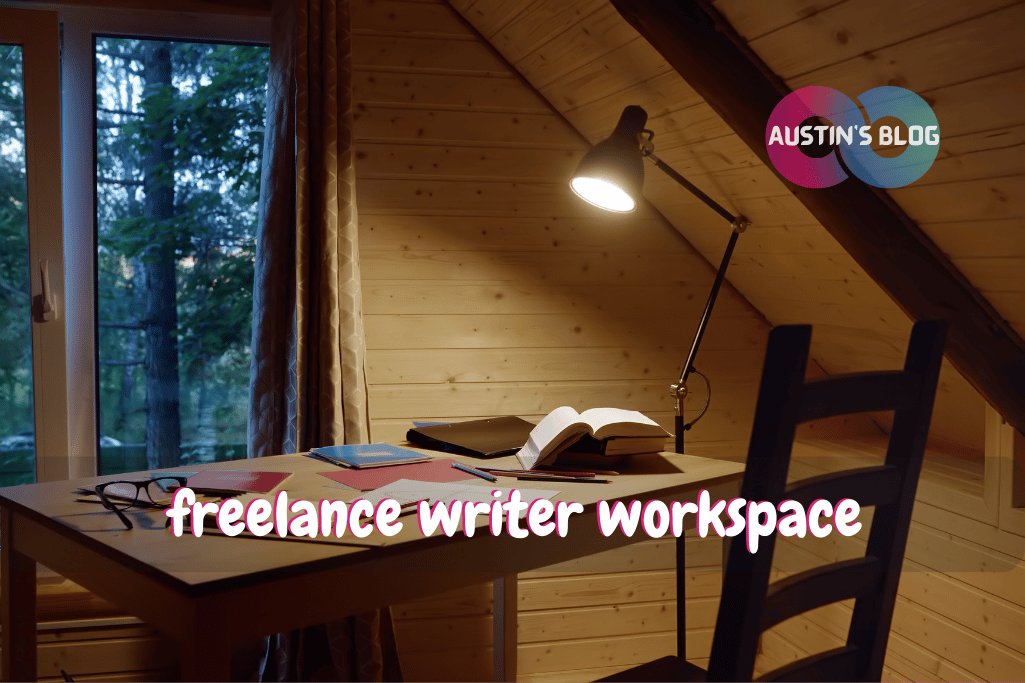Maximize Your Productivity: Design Your Ideal Freelance Writer Workspace
Introduction
Did you know that a well-designed workspace can increase productivity by up to 20%? [1], [2],[3].
For freelance writers, where creativity flows and deadlines loom, the right environment isn’t just a luxury – it’s a crucial ingredient for success.
Welcome to the world of freelance writer workspaces, where the perfect blend of comfort, functionality, and inspiration can transform your writing career.
As a freelance writer, your workspace is more than just a desk and a chair. It’s your creative sanctuary, your productivity powerhouse, and often, the place where you spend the majority of your waking hours.
Whether you’re crafting compelling web copy, penning the next great novel, or churning out technical documents, your environment plays a pivotal role in your output and overall job satisfaction.
But what exactly makes a great freelance writer workspace?
Is it all about having the latest ergonomic chair or the most cutting-edge technology?
How do you create a space that not only meets your practical needs but also ignites your creativity and keeps you motivated through long writing sessions?
And how can you optimize your workspace regardless of whether you’re working from a dedicated home office, a corner of your living room, or even a local café?
In this comprehensive guide, we’ll explore the art and science of creating the perfect freelance writer workspace.
We’ll delve into the essential elements that every writer’s workspace should have, from ergonomic furniture to inspiring decor.
We’ll look at different types of workspaces suited to various writing styles and lifestyles, and offer ideas for different writing niches.
Whether you’re on a shoestring budget or ready to invest in your dream setup, we’ve got tips and ideas to help you create a workspace that works for you.
So, grab your favorite notebook (or open a fresh document), and let’s embark on this journey to design your ideal writing environment.
Your perfect workspace – and your best writing – awaits!
Why Your Freelance Writer Workspace Matters
Before we dive into the specifics of creating a great workspace, let’s explore why it’s so crucial for freelance writers. Understanding the impact of your environment can motivate you to invest time and resources into optimizing your workspace.
Impact on Productivity and Focus
Your workspace can significantly affect your ability to concentrate and produce quality work.
How it matters:
– A clutter-free environment reduces distractions
– Proper ergonomics minimize physical discomfort, allowing for longer writing sessions
– A well-organized space helps streamline your workflow
I once transformed a chaotic corner of my living room into a dedicated writing nook, and my daily word count nearly doubled.
Influence on Creativity and Inspiration
The right environment can spark ideas and fuel your creative process.
Why it’s important:
– Surrounding yourself with inspiring elements can trigger new ideas
– A comfortable space allows your mind to wander and explore creative thoughts
– The right ambiance can help you get into a creative “flow” state more easily
After adding a small inspiration board near my desk, I found myself coming up with more innovative ideas for my articles.
Effect on Physical Health and Comfort
Your workspace setup directly impacts your physical well-being.
Key considerations:
– Ergonomic furniture can prevent back pain, neck strain, and repetitive stress injuries
– Proper lighting reduces eye strain and headaches
– A well-ventilated space keeps you alert and comfortable
Investing in an ergonomic chair was a game-changer for me – I no longer ended my workday with an aching back.
Role in Maintaining Work-Life Balance
For freelancers working from home, a dedicated workspace helps separate work from personal life.
Why it matters:
– A designated work area helps you “switch off” at the end of the day
– It signals to family members or roommates when you’re in work mode
– A proper setup reduces the temptation to work from less productive spaces (like your bed)
Creating a dedicated office space in my home helped me establish clear boundaries between work time and personal time, improving both my productivity and my relationships.
Professionalism and Client Perception
Your workspace can influence how clients perceive you, especially in the age of video calls.
How it impacts your career:
– A professional-looking background boosts credibility during video meetings
– An organized space reflects well on your work habits
– A thoughtfully designed workspace can be a talking point, potentially impressing clients
I once landed a major client partly because they were impressed by the professional setup they saw during our video call.
Longevity in Your Career
A well-designed workspace contributes to your long-term success and satisfaction as a freelance writer.
Long-term benefits:
– Reduces the risk of burnout by creating a pleasant work environment
– Supports your physical health, allowing for a longer, more comfortable career
– Adapts to your changing needs as your career evolves
After a decade of freelancing, I credit my carefully curated workspace with helping me avoid the burnout that many of my colleagues have experienced.
Remember, your workspace is a reflection of your commitment to your craft. It’s an investment in your career, your health, and your overall well-being as a freelance writer.
In our next section, we’ll explore the essential elements that every freelance writer’s workspace should include. Get ready to transform your writing environment!
Essential Elements of a Freelance Writer Workspace
Creating an effective workspace involves more than just finding a flat surface for your laptop. Let’s explore the key components that can elevate your writing environment from functional to fantastic.
1. Ergonomic Furniture
Investing in ergonomic furniture is crucial for your health and productivity as a writer.
Choosing the right desk and chair:
– Look for a desk with adjustable height to alternate between sitting and standing
– Choose a chair with good lumbar support and adjustable features
– Consider a balance ball chair for core engagement and improved posture
Importance of proper posture:
– Maintain a 90-degree angle at your elbows when typing
– Keep your feet flat on the floor or use a footrest
– Position your screen at eye level to avoid neck strain
Accessories for ergonomic support:
– Use a keyboard tray to maintain proper wrist position
– Invest in a vertical mouse to reduce wrist strain
– Consider a document holder to keep reference materials at eye level
After switching to an ergonomic setup, I found I could write for longer periods without discomfort, significantly boosting my productivity.
2. Lighting
Proper lighting is essential for reducing eye strain and maintaining focus.
Natural vs. artificial light:
– Position your desk near a window for natural light when possible
– Use full-spectrum light bulbs to mimic natural daylight
– Consider a light therapy lamp for darker months or windowless spaces
Best lighting options for reduced eye strain:
– Invest in an adjustable desk lamp with multiple brightness settings
– Use indirect lighting to reduce glare on your screen
– Consider bias lighting behind your monitor to reduce eye fatigue
Creating a well-lit workspace:
– Aim for a combination of ambient and task lighting
– Avoid harsh overhead lighting that can cause glare
– Use dimmer switches to adjust light levels throughout the day
Improving my workspace lighting not only reduced my eye strain but also helped regulate my sleep patterns, especially when working late.
3. Technology Setup
The right tech can significantly enhance your writing efficiency.
Essential hardware for writers:
– A reliable laptop or desktop computer with sufficient processing power
– A comfortable, responsive keyboard (mechanical keyboards are popular among writers)
– A large monitor or dual-monitor setup for improved productivity
Software and tools for productivity:
– Writing software like Scrivener or Google Docs
– Project management tools like Trello or Asana
– Time-tracking apps like RescueTime or Toggl
Setting up a reliable internet connection:
– Invest in a high-speed internet plan
– Consider a backup internet option (like a mobile hotspot) for crucial deadlines
– Use a VPN for security when working in public spaces
My dual-monitor setup has been a game-changer, allowing me to research on one screen while writing on the other.
4. Organization and Storage
A clutter-free space is crucial for maintaining focus and productivity.
Decluttering strategies:
– Adopt a minimalist approach to your desk setup
– Use the “one in, one out” rule for office supplies
– Regularly purge unnecessary items from your workspace
Effective storage solutions:
– Invest in a filing cabinet or storage boxes for physical documents
– Use desk organizers for frequently used items
– Consider wall-mounted shelves to maximize vertical space
Digital organization tools:
– Use cloud storage services like Dropbox or Google Drive
– Implement a consistent file naming system
– Utilize bookmarking tools to organize online resources
Implementing a strict organization system helped me reclaim hours of time previously lost to searching for documents or supplies.
5. Inspiration and Personalization
Your workspace should reflect your personality and inspire your writing.
Adding personal touches to your workspace:
– Display meaningful photos or artwork
– Use a bulletin board for inspirational quotes or project ideas
– Incorporate plants for a touch of nature and improved air quality
Creating an inspiring environment:
– Choose a color scheme that promotes creativity and focus
– Create a vision board related to your writing goals
– Rotate decorative elements to keep your space feeling fresh
Balancing functionality with aesthetics:
– Choose storage solutions that are both practical and visually appealing
– Opt for desk accessories that reflect your personal style
– Use cable management solutions to keep your space tidy
Personalizing my workspace with items that inspire me has made it a place I genuinely enjoy spending time in, which has positively impacted my writing output.
Remember, the perfect workspace is one that caters to your specific needs and preferences as a writer. It’s worth taking the time to experiment with different setups until you find what works best for you.
In our next section, we’ll explore different types of freelance writer workspaces, from home offices to mobile setups. Each has its unique advantages and challenges, and understanding these can help you create the ideal environment for your writing career. Stay tuned!
Types of Freelance Writer Workspaces
Every freelance writer’s situation is unique, and the ideal workspace can vary depending on your lifestyle, preferences, and writing needs. Let’s explore some common types of workspaces and how to make the most of each.
1. Home Office
For many freelance writers, a dedicated home office is the dream setup.
Advantages:
– Complete control over your environment
– No commute, saving time and money
– Tax deductions for home office space
Challenges:
– Potential for home distractions
– Difficulty separating work and personal life
– Limited social interaction
Tips for creating a dedicated home office:
– Choose a quiet area of your home, preferably with a door
– Establish clear boundaries with family members or roommates
– Invest in noise-cancelling headphones for focus
I converted a spare bedroom into my home office, and it’s dramatically improved my work-life balance. Having a separate space allows me to ‘leave work’ at the end of the day, even though I’m still at home.
2. Co-working Spaces
Co-working spaces offer a professional environment outside the home.
Benefits of shared workspaces:
– Networking opportunities with other professionals
– Access to amenities like high-speed internet and meeting rooms
– Separation between work and home life
How to choose the right co-working space:
– Consider location and accessibility
– Check the noise levels and availability of quiet areas
– Look for spaces that offer flexible membership options
Making the most of co-working environments:
– Establish a routine to maintain productivity
– Take advantage of networking events and workshops
– Use quiet areas or book meeting rooms for focused work
I use a co-working space twice a week, which gives me a change of scenery and helps combat the isolation of full-time home working.
3. Mobile Workspaces
For writers who love to travel or work from various locations, a mobile setup is key.
Setting up a portable office:
– Invest in a lightweight, durable laptop
– Use cloud storage for easy access to files from anywhere
– Consider a portable second monitor for increased productivity
Best tools for working on-the-go:
– Noise-cancelling headphones
– Portable Wi-Fi hotspot
– Ergonomic laptop stand for better posture
Maintaining productivity while traveling:
– Establish a routine, even when in different locations
– Use productivity apps to stay on track
– Find reliable workspaces in advance (e.g., quiet cafes, libraries)
My mobile setup allows me to work from anywhere, which has been great for inspiration and avoiding creative ruts.
4. Outdoor Workspaces
Working outdoors can boost creativity and provide a refreshing change of pace.
Benefits of working in nature:
– Increased exposure to natural light
– Potential boost in mood and creativity
– Change of scenery to combat writer’s block
Creating an outdoor office setup:
– Invest in weather-resistant furniture
– Use an anti-glare screen protector for your laptop
– Consider a portable power bank for extended working sessions
Overcoming challenges of outdoor work:
– Plan for potential Wi-Fi issues with a mobile hotspot
– Protect your equipment from the elements
– Be prepared for distractions and variable weather conditions
On nice days, I love to work from my backyard patio. The fresh air and natural surroundings often spark new ideas for my writing.
Workspace Ideas for Different Writing Niches
Different types of writing may benefit from specialized workspace setups. Here are some ideas for common writing niches:
1. Creative Writing Spaces
Fostering a creative atmosphere:
– Use ambient lighting or candles to set the mood
– Display inspiring artwork or vision boards
– Create a cozy nook with comfortable seating for brainstorming
Tools and accessories for fiction writers:
– Storyboarding software or a physical corkboard for plotting
– Comfortable headphones for immersive writing sessions
– Reference books on writing craft and genre-specific guides
Incorporating inspirational elements:
– Create a character wall with images and notes
– Use changeable wallpaper or decorations to match your current project’s theme
– Keep tactile objects related to your story for sensory inspiration
My creative writing space includes a soft reading chair where I often sit to review and edit my work, helping me see it from a new perspective.
2. Technical Writing Setups
Organizing resources and references:
– Use multiple monitors for easy access to documentation
– Implement a digital knowledge base for quick reference
– Invest in specialized technical writing software
Dual monitor setups for efficiency:
– Use one screen for writing and another for research or diagrams
– Consider a vertical monitor for viewing long documents
– Utilize screen-sharing software for collaboration with subject matter experts
Creating a distraction-free environment:
– Use website blockers during focused writing time
– Implement a minimalist desk setup to reduce visual clutter
– Consider soundproofing options for a quiet workspace
My technical writing setup includes a large whiteboard for mapping out complex processes, which has been invaluable for organizing information.
3. Content Marketing Workspaces
Incorporating collaboration tools:
– Set up a dedicated area for video calls and virtual meetings
– Use a large monitor or TV for presenting ideas to clients
– Invest in a good quality microphone and webcam
Setting up for video calls and meetings:
– Create a professional background for video calls
– Ensure good lighting for clear video quality
– Have a space to display visual aids or samples of your work
Organizing multiple client projects:
– Use color-coding systems for different clients or projects
– Implement project management software for tracking deadlines
– Create a physical or digital idea board for content brainstorming
I’ve found that having a dedicated “client call corner” with good lighting and a professional background has significantly improved my client interactions.
Remember, the key to a great freelance writer workspace is personalization. Use these ideas as inspiration, but don’t be afraid to experiment and find what works best for your unique writing style and needs.
In our next section, we’ll explore budget-friendly workspace improvements and tips for maintaining and evolving your workspace over time. Stay tuned for practical advice on creating your ideal writing environment without breaking the bank!
Budget-Friendly Workspace Improvements
Creating an ideal writing space doesn’t have to break the bank. Here are some affordable ways to enhance your workspace:
DIY Solutions for Ergonomic Support:
– Use a rolled-up towel for lumbar support
– Create a standing desk by stacking books or boxes on a regular desk
– Make a footrest from a sturdy box or step stool
I made a simple standing desk converter using a sturdy box and some scrap wood, which cost me nothing but dramatically improved my posture.
Affordable Lighting Options:
– Use desk lamps with adjustable arms from thrift stores
– Opt for daylight LED bulbs for better color rendering
– Create indirect lighting with string lights or LED strips
Switching to daylight bulbs in my desk lamp made a noticeable difference in reducing eye strain, and it was an inexpensive upgrade.
Low-Cost Ways to Personalize Your Space:
– Frame inspirational quotes or your own writing
– Use washi tape to decorate and organize
– Display potted plants or succulents for a touch of nature
I’ve decorated my workspace with framed pages from my favorite books, which serves as both inspiration and personalization.
Upcycling and Repurposing:
– Convert an old door into a spacious desk
– Use mason jars for organizing pens and office supplies
– Repurpose a ladder as a unique bookshelf
An old filing cabinet, painted and topped with wood, became a perfect printer stand and extra storage in my office.
Maintaining and Evolving Your Workspace
Your workspace should grow and change with you. Here’s how to keep it optimized:
Regular Workspace Assessments:
– Schedule monthly “workspace audits” to declutter and reorganize
– Reassess your ergonomic setup as your needs change
– Regularly update your tech setup to maintain efficiency
I set a reminder for the first of each month to tidy and reassess my workspace, which helps me stay organized and productive.
Adapting to Changing Needs and Trends:
– Stay informed about new ergonomic research and products
– Be open to rearranging your space for better flow
– Experiment with new organizational systems
When I started taking on more video call clients, I rearranged my office to create a more professional background for calls.
Incorporating New Technologies:
– Research and integrate new writing software or tools
– Consider upgrading to more energy-efficient and ergonomic equipment
– Explore smart home technologies for improved workspace comfort
Adding a smart light bulb that I can control with voice commands has made it easier to adjust my lighting throughout the day.
Seasonal Adjustments:
– Modify your workspace for changing seasons (e.g., add a fan in summer, a heater in winter)
– Rotate decor to keep your space fresh and inspiring
– Adjust lighting as natural light changes with seasons
I switch out my office curtains seasonally – light, airy ones in summer and cozy, insulating ones in winter – which helps manage both the temperature and atmosphere of my workspace.
Conclusion
Creating the perfect freelance writer workspace is an ongoing process, not a one-time event.
It’s about crafting an environment that not only meets your practical needs but also inspires your creativity and supports your well-being.
Whether you’re working from a dedicated home office, a corner of your living room, or a favorite café, the key is to create a space that works for you.
Remember, the best workspace is one that enhances your productivity, creativity, and job satisfaction.
It should be a place where you feel comfortable spending long hours, where your ideas flow freely, and where you can produce your best work.
As you implement these ideas and create your ideal writing space, keep in mind that flexibility is key. Your needs may change over time, and your workspace should be able to evolve with you.
Don’t be afraid to experiment with different setups, tools, and arrangements until you find what works best for you.
We’d love to hear about your freelance writing workspace! What elements have you found most crucial for your productivity and creativity?
Do you have any unique or innovative solutions for common workspace challenges? Share your experiences and tips in the comments below – your insights could be invaluable to fellow writers looking to optimize their own workspaces!
Remember, your workspace is a reflection of you as a writer. Make it a place where you love to work, and your writing will flourish. Here’s to creating spaces that inspire great writing and successful freelance careers!
Happy writing, and may your workspace be the launchpad for your best ideas and most productive days!
Frequently Asked Questions: Freelance Writer Workspace
Q: What are the essential elements for setting up a freelance writing workspace in 2025?
A: When setting up your freelance writing workspace, you’ll need to consider elements such as a comfy chair, a sturdy desk, and a reliable laptop. It’s essential to find a workspace that inspires creativity and productivity. You may also want to incorporate natural light and minimize clutter to enhance your work environment.
Q: How can I create an active workspace for my freelance writing business?
A: An active workspace can be achieved by incorporating elements that encourage movement, such as a standing desk or a balance ball chair. You’re going to want to ensure that your workspace allows for flexibility and comfort, promoting a healthier workday.
Q: What are the benefits of using a coworking space for freelance writing?
A: A coworking space offers freelancers the opportunity to work in a professional environment alongside like-minded individuals. It can provide networking opportunities, reduce the feeling of isolation, and offer amenities that might not be available in a home office setup, such as meeting rooms and high-speed internet.
Q: How important is natural light in a freelance writer’s workspace?
A: Natural light is crucial as it can significantly impact mood and productivity. A workspace with ample natural light can reduce eye strain and create a more pleasant and inspiring atmosphere for writing projects.
Q: What role does organization play in building a successful freelance writing business?
A: Organization is key to managing client work, meeting deadlines, and maintaining a clear inbox. Using tools like a to-do list, folders for different writing projects, and an invoice template can help keep your freelance writing business running smoothly and efficiently.
Q: How can I make my home office setup more inspiring?
A: To create a workspace that inspires, you’ll want to personalize your home office setup with items that motivate you, such as artwork, plants, or a vision board. Ensuring that the rest of the room is tidy and organized can also contribute to a more inspiring environment.
Q: What are some tips for maintaining productivity throughout the workday as a freelance writer?
A: To maintain productivity, it’s important to set clear goals and prioritize tasks using a to-do list. Taking regular breaks, staying hydrated, and enjoying a cup of coffee can also help keep energy levels up. Additionally, setting boundaries to minimize distractions will allow you to focus on your writing projects more effectively.
Q: How can a freelance writer effectively manage their inbox?
A: Managing your inbox involves setting aside specific times to check and respond to emails, using folders to categorize messages, and employing filters to prioritize important client work. This approach helps ensure that you’re not overwhelmed by emails and can focus on more critical tasks.
Q: What should a freelance writer consider when choosing a desk for their workspace?
A: When choosing a desk, you’ll need to consider factors such as size, storage options, and ergonomics. A desk that fits well within your space and provides enough room for your laptop and other essentials is crucial for a productive work environment.






